
Studies show clients want their financial advisors to dig deeper into their altruistic motivations and values to help them with their goals for leaving a lasting legacy. Indiana University identified several questions that help donors discover for themselves what they want to articulate to advisors. “The Philanthropic Autobiography” is an adaptable tool used by philanthropy professionals. It helps donors reflect on who they are and think closely about their involvement in giving.
Back in 2006, Bank of America tapped the research expertise of the Center on Philanthropy at Indiana University for a comprehensive, multi-year study of philanthropic behaviors of high-net-worth individuals and their financial advisors. This blockbuster study touched a nerve, in a good way. Iterations of the study have been repeated every year or two, and insights continue to emerge as recently as October 2024[1].
A persistent takeaway is the disconnect between financial advisors and their clients’ perceptions of the conversation about philanthropy. Consistently between 80% to 90% of advisors surveyed agree that philanthropy is important and they discuss it with their clients regularly. Just as doggedly, over half of high-net-worth clients do not feel satisfied with the philanthropic discussions with their advisors.
Digging deeper, clients complain that they bring up social needs they would love to address philanthropically, but their advisors rush to one of these common responses:
- The advisor is eager to discuss the tax benefits of charitable giving.
- The advisor wants to demonstrate their technical expertise of different estate planning vehicles.
- Or the opposite: The advisor is completely unfamiliar with philanthropic gift planning.
- The advisor is unfamiliar with the nonprofit sector and therefore cannot help the client form an impactful philanthropic strategy for social change.
The Lilly Family School of Philanthropy at Indiana University (the successor to the Center on Philanthropy) states the obvious on this matter: Advisors should first explore their clients’ altruistic motivations and values. This is what the clients want. It’s about making the world a better place, about their lasting impact, not “charity.”
To help facilitate the joy of giving, Indiana University identified several questions that help donors discover for themselves what they want to articulate. “The Philanthropic Autobiography” is an adaptable tool used by philanthropy professionals. It helps donors reflect on who they are and think closely about their involvement in giving. It guides them to recall how they experience and learn about charitable giving. It uncovers what in their life story motivates them to volunteer their time and give their money and expertise for the benefit of others. The “original” version of the Philanthropic Autobiography is probably long lost, but here are common questions in versions I have seen and used.
- What is your earliest memory of giving or receiving?
- Did your family talk about money in your home? What did you learn from your family about giving?
- What are some of the practices of giving that you remember from your childhood?
- Who most deeply touched your life or influenced your family as a giver? What makes this mentor or hero so admirable?
- To what people and places do you feel a sense of gratitude?
- What is the most meaningful or memorable gift you ever received?
- What is the most meaningful or memorable gift you have made thus far?
- What values do you hold most dear?
- How do you want to be remembered by your family and friends?
Feel free to use these questions and comprise some of your own. We all want to see our clients’ dreams come true. Philanthropy does just that and brings the greatest sense of satisfaction to donors who, with your help, make the right decision.
At McKinley Carter Wealth Services, we understand that philanthropy is about more than just tax strategies or financial vehicles — it's about enabling clients to make a meaningful difference in the world. We know that each donor has a unique story, and by taking the time to explore their values and motivations, we help clients build a philanthropic legacy that truly aligns with their goals. Through tools like the Philanthropic Autobiography, we guide clients in articulating their vision, shaping their charitable journey to reflect who they are and what they believe in.
[1] A collection of these reports can be found at https://hdl.handle.net/1805/6309.
The above article was written by Dr. Z. Allen Abbott, of the Baptist Homes Foundation, for the purpose of sharing with McKinley Carter's Noteworthy for Nonprofits readers.
